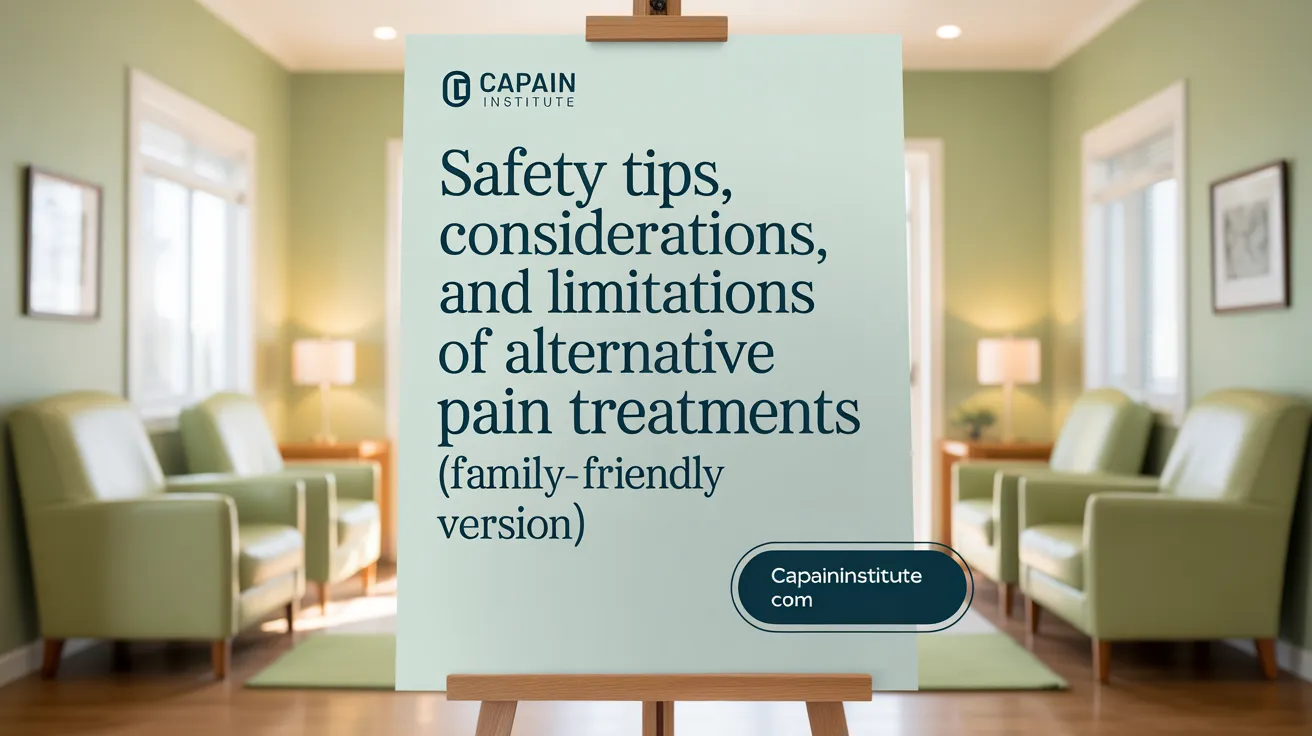Understanding the Rise of Alternative Therapies
With chronic pain affecting millions worldwide and concerns about the risks of opioid use intensifying, alternative therapies offer promising options for pain management. This article explores a wide range of evidence-based, non-pharmacological treatments that address the complex nature of chronic pain while minimizing side effects and improving overall quality of life.
<!-- VIDEO:eyJsaW5rIjoiaHR0cHM6Ly93d3cueW91dHViZS5jb20vd2F0Y2g/dj1zNzlXOUJianktVSIsImltYWdlVXJsIjoiZGF0YTppbWFnZS9qcGVnO2Jhc2U2NCwvOWovNEFBUVNrWkpSZ0FCQVFBQUFRQUJBQUQvMndDRUFBa0dCd2dIQmdrSUJ3Z0tDZ2tMRFJZUERRd01EUnNVRlJBV0lCMGlJaUFkSHg4a0tEUXNKQ1l4Sng4ZkxUMHRNVFUzT2pvNkl5cy9SRDg0UXpRNU9qY0JDZ29LRFF3TkdnOFBHamNsSHlVM056YzNOemMzTnpjM056YzNOemMzTnpjM056YzNOemMzTnpjM056YzNOemMzTnpjM056YzNOemMzTnpjM056YzNOLy9BQUJFSUFGTUFsQU1CSWdBQ0VRRURFUUgveEFBYkFBQUJCUUVCQUFBQUFBQUFBQUFBQUFBREFBRUNCQVVHQi8vRUFEVVFBQUlDQVFJRUJBTUdCZ01CQUFBQUFBRUNBQU1SQkNFRkVqRkJFMUZoY1NJeWdRWVVJNUhCMFROQ1VuS3g4Q1JEVXhYL3hBQVpBUUFEQVFFQkFBQUFBQUFBQUFBQUFBQUJBZ01BQkFYL3hBQWZFUUFEQVFBQ0F3QURBQUFBQUFBQUFBQUFBUUlSSVRFREVsRVRJa0gvMmdBTUF3RUFBaEVERVFBL0FBb3NPb2tFRUtzUWNrQk1yai9DZnZ0WXZvWDhkQmpBL25YeW11SVJWSmdDZVI2Nmp3N0R0Z3lwTi9pNSs4NjdWTjJOejhwOWppWWxpRkd3WTFTNTdNcVQ2TFBDTmUyZzFKTERtb3MrRzFEMEk4L2NUYzF1alZQeHFQNGJkSnpHTXpkNFB4UVY2Zjducmd6Vi93RFhabmRQUStreWFheG1hYTVSSUVpT0dZTUNERmJWeVdGYzVBajFsVllCakpOWU9qWTRSUUZIaTJiZVVQeG16L2hJd2RrSWZPMjJ3Qm1kYnhCS0Fxb2VZS0F4d09nZ2J1Si8vUW9PbldraDJiNWlmbFQ5ekpTbTYwSlQwNk5jemFtOGtzL24ybFRYTUJzSnE2cmxvbzVlaG5QM01iTENUMGx6TllnWkpWR1lic2RsOTU2MXdocTI0WnBVcnVxdU5kU296Vk1DTWdZTThrSE5iWW9USUFQV2FsRnR1bmJuUXNyZjFWdGd5a1BDTmNucUxDQmNUaTlMOXFOYlJzOWkzcU8xb3dmemt0ZjlzcmJLd3Vpb1dwOGZFN25teDdEOTQ3cEM0ZERyT0o2RFIzZUZxOVpSVlpqUEs3Z0hFYWVhMy9qM1BkYzdQWTU1bVluY21LTDdvT0hxcVFnd0JsamlaRm5GTzFTL1V3UWJVNnM0R1c5QjBrdmI0UGhyM2ErbW9ZVTg3ZVFsTitJWDNIbHJIS1BJU1duNFlkamMzMFdhRk9tU3RTSzBDNWd5bjJiVHpUeHNjN1BrNUpPWm4zM0FFN2N5bVdiU1F1OHpkUWZpblpiNHdoUERDQmgxVTVFc1UyRG8yNG1kVVhOcXJVT2F4aUZWZk1tYnZHdUNXOEpzcVUzVlhGMXlSVWNsRDNCbkxVNmRFMHlLWE5TdXg1MFBRZHhGVmNtUzF5bGlkc2N4R1B5bEVPL3k5NFFFazd4T2N3Y1BhcHNRK0c1V3ZPNFVaSm0xd3ZSL2M5SnozSExrWnlmOFNod2lrUGJ6V05oRjN3ZTVsaml1dUNxYTBPVG1HVmd4VDRucStkK1JEdEtkYWpCSjZ3TFdEZGlRVDBBOTRib3hFREFsbzZ1dGI3cUFUM2hiTDFRREl3VDJQN3l1MkdHQ0FmUXlxamVEZHluZXQreGp5OUpVc0RhcTJ3Z1pVQmZRNWxkYmp2NVF6cnlqQStROUI1U3VWK0pjRGM3UW9RS0xNeFRUMEhBcjlWcC9GQVVESkh4SEVhRDJSdVR2dEx3dXRNR3dsejVkQk5PdWtLQUZBQThoSHJXV0ZXUGlRZEdTdjBoVVRjU3ByK0k2Zmg5WWE0NWMvTFd2VnB5M0V2dEJxcnd5cS9ncC9SV2QvcWVzdzh3Nk9jMUdqdHMxRnFxQXFCMkhNM1RySWpoMm1yT2JQeEc5ZGgrVXNYYWhtN3lzems5VEM2YktUNHBra3oxMURsclJWOWxnV3RiT3hpeEdLa3FUNVJSeEM1a2JuR01qdVJtUzhhM1V0aW9LWE8yQWtHVitzMitCVjFWY0kxRnFLcHY4VWdrK1FBSS96RWFGS3VxRGFQVEJLK1hteDhSODVoMjJ1ekhtNnpxYjY2dGJYVFpYdXJqOHBrY1E0ZUVwZGsrWmQ0djVGdUFxV1pmVmNlMHM1eVNaVnIzbGhNanJEU05KRnVtOHJYRFBLVDF6Zys4dEVqSkVxWEhMZW5OREl2azZDTVNLbERibllTL3d2UU5xcmF3T3I3Zy8wcjNQKytjb0JXZkw4cFpFM2JCeHRPNTROcEJScEZ0UEw0bHloank5QXZaUjZSZkpmcWljclN6V2lWSXRkYThxS01BZWthRUlpbko3Rk1PaXI2VEs0cng1ZEt6VTZURDJqWm5KMlUvcVpMait0YlE4S3Rzck9MSHhXaDhpZS8wR1RPSUYzWEc2cnNQVXowZ2VPVStXWE5WcWJMckdzc2RuZHVySHJLZGpIdkoya3JXVDN4djd3RjdmQWplY3hjZ1pFN3dtTmhtUVk0Z0FSUHkrb2pjM0tjaU56YndiSHRBWVJPRzJPM1VlMDFPRGNWMHVoMDJzcDFRc1BQaDZnZzZub1FUK1V5RHV2cXU0OW8zekx0MUc0Z0FYdURhMWwxRnRYL3BrcUQyTXUrS3pPeXZqeWJQbk1qUjJwcDlWWGN5aGwrVnNqcG52OUpvVzNlRnFUem9DQ000N0hIK2lROGsvQXl6SHZxKzc2aDFBK0VicjdTUTNRR0Y0bzNpc3RnQUhNU3ZLT3c2L3JCQWNxQmZTT24rdkl2VElPUjRpL3dCdjZ3S296OGlvTXN4MmtyeUFVT2NkcHBjRXA4ZGxybzN1WVpaKzFTL3ZDM2kwblhMdzAvcy9vVnRzUUhsYW5UTmwrL1BZUi9nZEowN0FkQjBnTkpUWHBLdVNpdFVVNHlBT3YxaHVaY2VSOHB4WGZ1OUhTeEVDTjQwZUtMeVlCOXRpdzRmcFNvSkExQXo3OHB4T1VxS1VCZkZPWHgwSGFkcDlxbDhUZ2x1RzVjTXA1c2JqZkczcnZPSVFJR3dpNDh5VGt6MVJmSDBIdHRESWRzQ1ZuWW1nQTlWYUxXMm10VXJUNW5NamI4RkFIcUpoMnl6L0FDajJnbjZ5WE4wOW9OMmdEcEZqQk1aSm1rSXJCb2djRWVzaWZnYkhicUk1NlJtM1VlWWdBeEhHU094bG11NG43dWJRWENzVXo2WWxRdGtlMFN0aGxic3B6RnBhYlN4cW1GaFRLa01DRDZZeGo5Slhzc0M3RGR6MEVKZllianpNUWlnWUdCMEdUKzhiU1VCck00d29nU3hHcXNKVmNPT3BRYzl2SzVkVlhiek84Ni9obWlwNGZRS3F0em5MUGpkak0zZytuTnRuM3BoK0VtMUk4ejNhYlFuTDU3YmZxQ0ovb2NIOG9OMkJNUmZsR0lJc0pGSVlmblliWmlneTU4NG8yQUNmYkN4bDRiV3FzUXIyZkVQUEF6T05VbmxVOThDS0tlcSt4STZCYW81MWRHZldUMUovQ1grNFJSVERmUTNZUVR4UlRNSUtQMmlpaUFHTUdZOFVBUWY4d2swNng0b0dCQXlUOEk3UzJmNGRhZnlzNFZoNWd4NG9IMEpYWjJQS3RlSzBBVkZBQUE3REVJblNLS2VhK3lwRitzQ3gzaWlqb0RJTjFpaWloQWYvMlE9PSIsInRpdGxlIjoiQ2hyb25pYyBQYWluIGFuZCBQYWluIE1hbmFnZW1lbnQ6IENvbXBsZW1lbnRhcnkgYW5kIC4uLiIsInNuaXBwZXQiOiJUaGlydHktZml2ZSBwZXJjZW50IG9mIGFkdWx0cyB1c2UgY29tcGxlbWVudGFyeSBhcHByb2FjaGVzIGxpa2UgY2hpcm9wcmFjdGljIGNhcmUsIG1hc3NhZ2UgdGhlcmFweSBhbmQgbWVkaXRhdGlvbiB0byBtYW5hZ2UgY2hyb25pYyBwYWluLiJ9 -->Diverse Alternative Therapies for Chronic Pain and Their Benefits

What are various alternative therapies for chronic pain relief and their general benefits?
A variety of non-traditional treatments are increasingly being used to manage chronic pain. Common approaches include acupuncture, massage therapy, chiropractic care, herbal medicine, and mind-body practices like meditation, yoga, tai chi, and hypnosis.
Acupuncture involves inserting very fine needles at specific points to stimulate the nervous system. Modern research supports its use for reducing conditions such as back pain, migraines, osteoarthritis, and fibromyalgia. It promotes the release of body’s natural painkillers, like endorphins, and helps balance energy flow.
Massage therapy manipulates soft tissues to relax muscles, improve blood flow, and release tension. It can provide temporary relief from neck, shoulder, low-back pain, and conditions like fibromyalgia.
Chiropractic care mainly uses spinal manipulation to address musculoskeletal issues. Evidence suggests it can help with low back pain, neck pain, and headaches, often with minimal risks.
Herbal medicine employs plant-based remedies such as devil’s claw, ginger, and turmeric to reduce inflammation and pain. While promising, these should be used with caution and under healthcare supervision due to potential interactions.
Mind-body therapies include meditation, guided imagery, biofeedback, and hypnosis. They focus on reducing stress responses, controlling physiological functions, and altering pain perception. These methods are particularly helpful in decreasing pain intensity and improving emotional well-being.
Overall, these therapies not only aim to relieve pain but also address emotional and psychological factors contributing to chronic discomfort. They can improve functionality, reduce dependence on medications, and enhance quality of life.
Conditions commonly treated with these approaches
| Condition | Typical Therapy(s) | Additional Benefits |
|---|---|---|
| Low back pain | Acupuncture, massage, chiropractic, yoga | Improved flexibility, reduced inflammation |
| Migraines | Acupuncture, hypnosis, biofeedback | Reduced frequency and severity |
| Osteoarthritis | Acupuncture, tai chi, herbal medicine | Improved joint function, reduced stiffness |
| Fibromyalgia | Massage, mindfulness meditation, yoga | Better sleep, reduced stress symptoms |
| Neck pain | Chiropractic, massage, yoga | Increased range of motion |
| Chronic headaches | Acupuncture, biofeedback, hypnosis | Decreased pain intensity |
These treatments are often used as part of an integrated approach tailored to individual needs, emphasizing holistic care and improving overall well-being.
Scientific Evidence Supporting Alternative Pain Management Approaches

What is the scientific evidence supporting the use of alternative pain management therapies?
Research on alternative pain management methods has significantly expanded, with many studies indicating their potential for effective relief. Systematic reviews and meta-analyses, which analyze multiple research trials, have found strong evidence supporting acupuncture's role in pain reduction, especially for conditions like chronic low back pain and migraines. These benefits can last for years after treatment.
Mind-body practices, including tai chi, yoga, and mindfulness-based stress reduction, have shown moderate benefits. They can decrease pain intensity and improve physical function, helping patients manage conditions like osteoarthritis, fibromyalgia, and chronic neck or back pain.
Therapies centered on soft tissue manipulation, such as massage and chiropractic care, also demonstrate some effectiveness, mainly for musculoskeletal problems. While the strength of evidence varies, clinical experiences suggest these treatments can lower pain and improve mobility.
Overall, the current body of research indicates that many of these non-drug approaches can positively influence pain outcomes. They are often used alongside traditional treatments, offering safer alternatives or complementary options. However, more high-quality, large-scale studies are needed to determine the best protocols and understand long-term benefits fully.
How Alternative Therapies Alleviate Chronic Pain: Mechanisms Explained

How do different alternative therapies work to relieve chronic pain?
Alternative therapies employ a variety of biological, neurological, and psychological processes to reduce chronic pain. For instance, acupuncture involves inserting fine needles at specific points on the body, which stimulates nerves and promotes the release of endorphins—the body's natural painkillers. This process helps modulate nerve activity and can enhance neuroplasticity, leading to pain relief.
Mind-body practices such as yoga and Tai Chi influence the body's autonomic nervous system, helping to balance stress responses, decrease inflammation, and improve muscle function. These gentle movements and breathing exercises can lessen muscle tension and improve joint mobility.
Manual therapies, including massage and spinal manipulation, directly target soft tissues and neural reflexes. Massage manipulates muscles and connective tissues to release tension, increase blood flow, and reduce muscle spasms. Spinal manipulation aims to correct misalignments, easing nerve compression and reducing pain signals.
Psychological approaches like cognitive-behavioral therapy (CBT) and mindfulness meditation alter how pain is perceived and emotionally processed. These techniques can change brain activity in pathways responsible for pain processing, diminishing the emotional distress often associated with chronic pain.
In essence, these diverse therapies work by acting on multiple levels—peripheral nerves, central nervous pathways, and emotional circuits—thus strengthening the body's own pain control systems and providing relief. They also address behavioral and mental factors that contribute to the experience of chronic discomfort, promoting a holistic approach to pain management.
Safety, Considerations, and Limitations of Alternative Pain Treatments

What are the considerations, safety concerns, and limitations of alternative therapies for managing chronic pain?
When exploring alternative methods for managing chronic pain, it is vital to understand both their potential benefits and their safety profiles. Many therapies, such as acupuncture, massage, chiropractic care, and herbal medicines, are generally considered safe when performed by qualified practitioners and used appropriately. For example, acupuncture releases endorphins and regulates neurotransmitter levels, providing relief for conditions like back pain and osteoarthritis. However, there are safety concerns to consider. Improper technique or unregulated practices can lead to adverse events such as bruising, soreness, or, rarely, more serious issues like infections, nerve damage, or stroke.
Herbal supplements and other natural products may interact with prescription medications or cause side effects, especially if not used under medical supervision. It’s crucial to consult healthcare providers before initiating these treatments, particularly for individuals with underlying health conditions or those taking ongoing medications.
Limitations of alternative therapies primarily revolve around their inconsistent evidence of long-term effectiveness. While some like acupuncture and manual therapies have shown sustained benefits in certain studies, many others tend to offer only transient relief that requires repeated sessions. Accessibility and insurance coverage can also pose barriers, limiting their widespread use. Patient expectations should be managed, as these therapies are typically adjuncts rather than replacements for conventional medical treatments.
Overall, integrating alternative therapies into a comprehensive pain management plan involves careful consideration of safety, ongoing medical supervision, and awareness of the current evidence base. Verifying the credentials of practitioners and the regulation status of products further reduces risk, helping patients benefit safely from these complementary approaches.
For more detailed information, searching for "Safety and limitations of alternative pain management" can provide additional insights into best practices and current research.
Natural and Holistic Pain Relievers: Herbs, Supplements, and Therapies

What are some strong natural pain relievers used in alternative pain management?
Several natural agents and therapies are commonly used to help manage pain without relying solely on pharmaceuticals. Herbal medicines like turmeric, which contains the active compound curcumin, are well-regarded for their potent anti-inflammatory and analgesic effects. Ginger is another popular herbal remedy, known for reducing inflammation and easing muscle soreness.
White willow bark has been traditionally used for pain relief due to its salicin content, which is chemically similar to aspirin. Capsaicin, derived from chili peppers, is frequently applied topically to diminish nerve and joint pain by decreasing the transmission of pain signals involving substance P.
Cannabidiol (CBD), a compound found in cannabis, interacts with the body's endocannabinoid system, helping to reduce inflammation and alleviate chronic pain conditions such as arthritis, multiple sclerosis, and nerve pain.
Beyond herbal remedies, other natural therapies support pain relief. Acupuncture stimulates specific points on the body to promote endorphin release and restore energy flow. Massage therapy reduces muscle tension and promotes relaxation, which can indirectly reduce pain.
Heat and cold therapies help decrease inflammation and numb pain sensations temporarily. Mindfulness meditation and guided imagery encourage mental relaxation, helping lower the perception of pain and improve emotional well-being.
In addition to these interventions, adopting an anti-inflammatory diet rich in vegetables, fruits, and omega-3 fatty acids can reduce systemic inflammation. Regular gentle exercise, such as walking, yoga, or tai chi, enhances joint mobility and reduces stiffness.
Overall, integrating these natural agents and holistic therapies into a comprehensive pain management plan can improve quality of life for those dealing with chronic pain while minimizing reliance on medications.
Holistic Lifestyle Approaches: Diet, Exercise, and Mind-Body Therapies for Pain
What natural and holistic approaches, including diet, exercise, meditation, and mind-body therapies, are effective for managing chronic pain?
Managing chronic pain often benefits from a comprehensive approach that combines lifestyle modifications with therapeutic interventions. A significant component of this strategy involves adopting natural and holistic methods that address both physical and mental aspects of pain.
An anti-inflammatory diet can play an essential role in reducing systemic inflammation, which is common in many chronic conditions. Such a diet emphasizes high intake of fruits, vegetables, whole grains, omega-3 fatty acids (found in fatty fish like salmon and flaxseeds), and reducing processed foods, sugar, and trans fats. This nutritional approach supports joint health, decreases pain, and can improve overall well-being.
In addition to dietary changes, engaging in low-impact physical activities is crucial. Gentle exercises like yoga, tai chi, swimming, and light stretching promote muscle strength, enhance joint flexibility, and facilitate relaxation. These activities are supported by evidence showing they can significantly reduce pain severity and improve function in conditions like osteoarthritis, fibromyalgia, and low back pain.
Mindfulness, meditation, and relaxation techniques are equally important in pain management. Practices such as diaphragmatic breathing, guided imagery, biofeedback, progressive muscle relaxation, and hypnosis help modify pain perception, decrease stress, and foster emotional resilience. These mind-body therapies can be tailored to individual preferences and are generally safe when performed correctly.
Complementary therapies like acupuncture, massage, and spinal manipulation, when conducted by qualified practitioners, add additional benefits with minimal risks. They work by promoting circulation, reducing muscle tension, and stimulating the body's natural pain-relieving mechanisms.
Incorporating these holistic strategies into a personalized pain management plan can lead to meaningful improvements. By addressing diet, activity levels, and mental health, individuals can achieve better control over their pain, enhance mobility, and improve their quality of life.
Integrative Approaches and Future Directions in Chronic Pain Management
Combining therapies for improved outcomes
Many healthcare providers now recommend combining multiple non-pharmacological treatments for better pain relief. For example, integrating acupuncture with physical therapy, massage, or mindfulness techniques can address different aspects of pain, such as physical discomfort and emotional stress. Studies show that a multimodal approach often yields more sustained benefits, reducing reliance on medications and enhancing overall quality of life.
Integration of alternative therapies in medical education and practice
Medical schools and hospitals are progressively incorporating training on alternative and complementary therapies. Professionals learn about acupuncture, massage, mindfulness, and physical modalities alongside conventional treatment methods. This integration helps clinicians offer personalized pain management plans that respect patient preferences and promote safer, holistic care.
Research advancements and NIH initiatives
Significant research efforts are underway to better understand and validate the effectiveness of integrative approaches. The NIH launched the HEAL (Helping to End Addiction Long-term) Initiative to explore non-drug therapies that could reduce opioid use in chronic pain management. The NCCIH funds numerous studies on mind-body therapies, acupuncture, and manual treatments, aiming to establish robust evidence and develop clinical guidelines for their use.
| Approach | Main Benefits | Ongoing Research Focus |
|---|---|---|
| Acupuncture | Pain relief, reduced medication use | Long-term effects, neurological healing |
| Yoga and Tai Chi | Improved flexibility, mood, balance | Chronic disease management, mental health effects |
| Mindfulness and Meditation | Pain reduction, stress decrease | Applications in opioid reduction and mental health support |
| Massage Therapy | Relaxation, muscle tension relief | Long-term pain management, fibromyalgia effects |
| Physical Therapy | Restoring movement, strengthening | Personalized rehab protocols, combine with other therapies |
As research progresses, combined approaches and integrative practices are expected to become standard components of comprehensive chronic pain management, offering safer alternatives and improving patient outcomes.
Towards Comprehensive Chronic Pain Care: Embracing Alternatives
Alternative therapies provide valuable, evidence-supported options for individuals seeking relief from chronic pain beyond conventional pharmacological treatments. By addressing the biological, psychological, and social aspects of pain, these approaches offer holistic benefits that can improve physical function, reduce medication reliance, and enhance quality of life. Ongoing research, integration into mainstream medical education, and patient-centered individualized care will continue to advance the role of complementary and integrative therapies in chronic pain management, fostering safer and more effective treatment strategies for diverse patient populations.
References
- 5 alternative treatments for chronic pain | UCLA Health
- Acupuncture, Tai Chi, Osteopathic Manipulative Medicine, and ...
- Alternative medicine - pain relief: MedlinePlus Medical Encyclopedia
- Chronic Pain and Complementary Health Approaches
- Managing pain differently: A look at alternative therapies - AAMC
- 8 natural ways to ease chronic pain - United Healthcare
- Pain Management: Alternative Therapy - WebMD
- 7 Ways to Treat Chronic Back Pain Without Surgery
